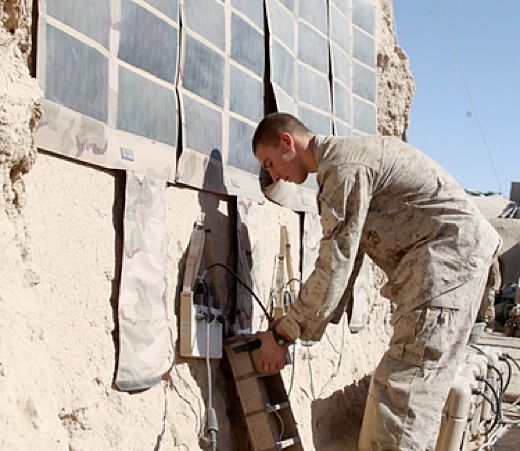 Image above: Lance Cpl. Dakota Hicks, from Laharpe, Ill., connects a radio battery to a portable solar panel From original article.
Image above: Lance Cpl. Dakota Hicks, from Laharpe, Ill., connects a radio battery to a portable solar panel From original article.
The heavy, mine-resistant vehicles that almost all U.S. military personnel use to move about Afghanistan are gas guzzlers. And even though the U.S. military buys that fuel at a reasonable price, the energy it takes to fly it and truck it to remote parts of Afghanistan drives the price into the stratosphere.
There's also a much greater cost, says Ray Mabus, secretary of the U.S. Navy.
"It's expensive in terms of getting us there financially. It's also expensive in the fact that for every 50 convoys, we lose a Marine, either killed or wounded, guarding that convoy," he says.
That cost, in both lives and dollars, is pushing the military to go green.
Practical Benefits Of Green Tech
The Navy has set the goal of using nonfossil fuels for 50 percent of its power by the year 2020. Mabus recently paid a visit to U.S. Marines in the remote Afghan province of Helmand, at the far end of the fuel supply chain, where some innovative green equipment is already in use.
Some of the solutions are incredibly simple: silvery tent liners that increase the efficiency of heaters or air conditioners. More novel are the portable solar-panel blankets, able to power communications gear for a patrol. That means carrying far fewer heavy batteries. There's also a small shipping container connected to a bank of solar panels that is powering flat screens and surveillance equipment.
Marine Capt. Brandon Newell says the troops don't have to be environmentalists to like the new gear.
"If the system works, they don't care. In fact, a Marine will love it if he has to refuel that generator less often. They'll love it. They don't care about the message or anything else; all they want is something that works whenever they need it," he says.
Newell admits that the measures so far are baby steps, and there are plenty of bugs in the system.
But the important thing, says Mabus, is that the U.S. military is starting to test some of the technology in the roughest conditions.
"When the military does something and shows that it works ... in the most critical circumstances, it makes it much easier to commercialize something," he says.
Environmental Impact A Side Benefit
That goes for solar panels, says Mabus, but also for biofuels. This fall, the Navy purchased half a million gallons of fuel made from algae or used cooking oil. In the spring, a huge exercise in the Pacific Rim intends to demonstrate that it works just as well as petroleum-based fuel.
Mabus says the strategic goal is to free the U.S. military from a product that comes from volatile places with unsavory regimes. He points out that during the NATO action in Libya, a spike in the price of oil cost the U.S. military about $1 billion. The environmental impact is a side benefit, he says.
"It really is a question of national security. It may be a side effect on climate change, being better stewards of the environment, but that's not the reason we're doing it," Mabus says.
Still, major environmental groups have reacted positively. And developers of biofuels and solar panels say having the Pentagon — the world's largest consumer of fossil fuel — trying to go green is providing a shot in the arm to their industry.
"It's a signal to investors that there is going to be stability. That is the game changer," says Sean O'Hanlon, president of the American Biofuels Council. "The bottom line is there has to be stable policy for them to invest hundreds of millions of dollars."
.
No comments :
Post a Comment